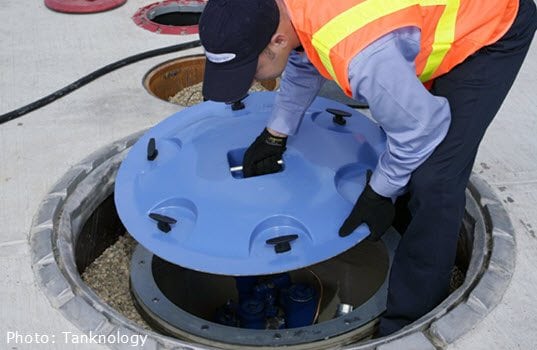Kevin Keegan, sent over a note to FMN with some new insights on some of the regulatory questions relevant to the new Underground Storage Tank regulations. He recently retired as Chief Operating Officer for Tanknology Inc. A 26-year Tanknology veteran, Keegan serves as a consultant to the company. Here is what he had to say:
Keegan: PMAA’s article [from Nov. 17, 2015] PMAA Reports on EPA Clarifications with the NEW UST Regs – Fuel Marketer News was very insightful. We wanted to share some additional thoughts and comments that Tanknology is considering as we work with our customer base to develop plans to incorporate the new requirements into our compliance testing strategies.
Keegan: If the interstitial space of the piping in continuous up to the impact valve where it passes through or terminates in the UDC then the UDC is not used as part of the piping secondary containment. I asked EPA via email if the OPW Flex Work system (photo below) meets this standard, which they declined to evaluate. Tanknology believes that the system does meet this standard hence UDC’s using this system do not require periodic testing to meet EPA’s requirement. Of course, State specific regulations may have other requirements.
Keegan: While the above touches on an important point, we believe that a related point could potentially offer marketers a much more significant cost savings strategy.
Sumps and UDC’s must be tested every 3 years ONLY IF the method used for piping release detection is interstitial monitoring (IM). Under the Federal regulation, if a system uses another method of piping or release detection such as SIR, electronic line leak detectors or annual precision line tightness testing then the sumps and UDC’s do not need to be tested even if sumps and UDC’s are present or regardless if the sumps are monitored. HOWEVER, while EPA states above that methods other than IM may be used for piping release detection for systems installed prior to April 11, 2016 they do not mention the mandate to use IM as the method of piping (and tank) release detection under the requirements of the National Energy Policy Act of 2005. Those states that opted for secondary containment verses financial responsibility (all but Missouri & Kansas) also had to require the use of IM for release detection. Therefore sites (sumps) installed on or after the effective date of the state’s secondary containment requirement must use IM for release detection and cannot avoid sump testing by using an alternative method of piping release detection. This does however offer a significant cost savings opportunity for marketers to use an alternative method of piping release detection at those sites installed prior to the state’s Secondary containment effective date.












